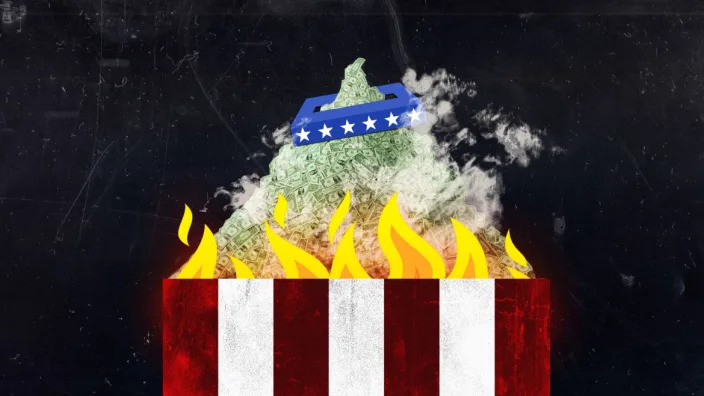Roger Sollenberger
Thu, November 17, 2022

Photo Illustration by Thomas Levinson/The Daily Beast/Getty
Pay Dirt is a weekly foray into the pigpen of political funding.
While the midterm elections dashed Republican hopes for a “red wave,” the green wave wasn’t much more kind to them either.
The Daily Beast reviewed the most expensive House and Senate races in the country, and found that, with a few exceptions, Republican candidates were on the losing end.
Republicans lost three of the five most expensive Senate races, per CRP data, with Democrats clinching the top three—Pennsylvania, Georgia, and Arizona. (The Georgia contest, where Sen. Raphael Warnock received the most votes, is headed to a runoff.)
While Republicans are now projected to win a slim majority in the House—far below their expectations—Democrats took all five of the most expensive races, according to CRP data.
Republicans also came up short in outside spending. The top two outside spending groups of the midterms, per CRP, were super PACs aligned with Republican Senate and House leadership, with their Democratic counterparts coming in third and fourth.
GOP Gets Its Consolation Prize: A Bare-Bones House Majority
Those two GOP groups alone had spent nearly $400 million on their efforts to take back the legislature just ahead of the election, where Republicans were favored to win. But Democrats—whose top two super PACs had only spent $225 million—defied the odds in the House and held their Senate majority, and they can still pick up a seat in Georgia.
The GOP’s Senate Leadership Fund super PAC alone spent nearly as much as its Democratic counterparts combined. It invested ads most heavily in Georgia ($39 million), with Pennsylvania (lost) and North Carolina (won) next.
Overall, the Senate money wasn’t evenly distributed, with wide gaps across the most expensive races.
The most costly battle overall—Pennsylvania—commanded a total of $374.4 million in spending, according to CRP data. That’s about $90 million more than the second-most expensive race, in Georgia; the tenth-most expensive, Missouri, only saw $65 million in spending—or about 17 percent as much as Pennsylvania.
The Republican Senate victories, however, are notable, because Democratic candidates—who have outraised Republicans this year—put more cash into most of those races, but still lost. Democrats saw this phenomenon in some marquee 2020 contests, where top-money draws like South Carolina’s Jamie Harrison and Kentucky’s Amy McGrath both came up short in the vote count that year.
The two most glaring discrepancies this time around were Val Demings in Florida (raising $72.3 million to Sen. Marco Rubio’s $46.6 million) and Tim Ryan in Ohio, who outraised his opponent J.D. Vance nearly four-to-one.
How J.D. Vance Found a Way to Love Trump and Win in Ohio
To some extent, the outcomes reflect widely reported GOP concerns this summer that Senate candidates in critical battleground states were struggling to raise money. Those concerns sparked a political budget crisis, with party leaders fighting over who was to blame and who could help make up the difference as the campaigns headed into the home stretch.
That air support was scattered. Where SLF focused on Pennsylvania, Georgia, and North Carolina, the National Republican Senatorial Committee spent more money on ads in Arizona ($9 million, per Politico) than any other state. The GOP candidate there, venture capitalist Blake Masters, failed to raise much money—$12.1 million as of Oct. 19, compared to Sen. Mark Kelly’s $81.8 million—and lost the election by more than five points.
But Republicans fared much worse in the House. While the GOP still eked out a majority, they haven’t won a single seat in the top 10 most expensive races, though two of them still remain too close to call as of this writing. The GOP’s Congressional Leadership Fund outspent its Democratic counterpart $188.1 million to $93.6 million to get there.
The total cost of the 2022 midterms is staggering. The Center for Responsive Politics projected the amount to exceed $16.7 billion—more than double the price tag in 2018. And with that much money on the line, blame spreads quickly.
The disappointment among Republicans has sent a shockwave through party ranks. Republicans now face a leadership crisis in both houses, including internal challenges to Senate Minority Leader Mitch McConnell and House Minority Leader Kevin McCarthy.
And to an extent, the crisis reflects the financial crisis that reared its head this summer. McCarthy, the top fundraiser in the House, now finds his presumed speakership at risk from a fractious, fiscally hawkish Freedom Caucus. And McConnell, aligned with SLF, has survived a challenge from NRSC leader Sen. Rick Scott (R-FL).
But Scott is taking flak, too. On Tuesday, Sens. Marsha Blackburn (R-TN) and Thom Tillis (R-NC) called for an audit of the NRSC’s midterm spending. Scott welcomed the prospect, and said he had worked to reform previous failures since taking over in 2021.
“When that’s your starting point, you work really hard to make sure there are transparent processes, and we are more than happy to sit down with any member of the caucus to walk them through our spending,” he said.
No comments:
Post a Comment